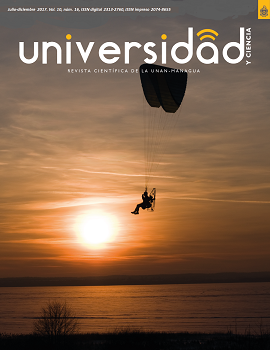Risk factors related to evisceration in patients undergoing laparotomy
DOI:
https://doi.org/10.5377/uyc.v10i16.6135Keywords:
evisceration, hernia, complication, surgical techniques.Abstract
The study aimed to analyze the relationship between the presence of conditions considered risk factors for evisceration and the occurrence of this complication in patients undergoing laparotomy in the Hospital Esc. Dr. Roberto Calderón during 2010-2012. It was a non-experimental, analytical, retrospective and correlational study. Patients undergoing Laparotomy Exploratory who presented evisceration (21 patients) and those who underwent laparotomy without presenting the complication (21 patients) were considered as cases. We tested for association between each of the risk factors and the presence of evisceration. Patients who were operated out of the care unit, those who followed a protocol of damage control, with a fast closure of the abdominal wall, and those with an incisional hernia in the first intervention were excluded. A statistically significant association was found between development of Evisceration and the Advanced Age (greater 60 years), Anemia and Infection of the surgical site. The presence of evisceration was independent of the presence of the other risk factors studied. It is recommended to rigorously apply measures aimed at reducing infections of the surgical site, improving the recording of weight and height of patients to identify those who are obese, as well as to study the influence of the manufacturing quality of the materials used in the closure of the abdominal wall and variants in surgical techniques as factors related to evisceration.
Downloads
1872
Downloads
Published
How to Cite
Issue
Section
License
Copyright © 2018 National Autonomous University of Nicaragua, Managua
This journal provides immediate free access to its content under the principle of making research available to the public free of charge, in order to foster the exchange of global knowledge.

This work is licensed under a Creative Commons Attribution-NonCommercial-ShareAlike 4.0 International License.</p?

